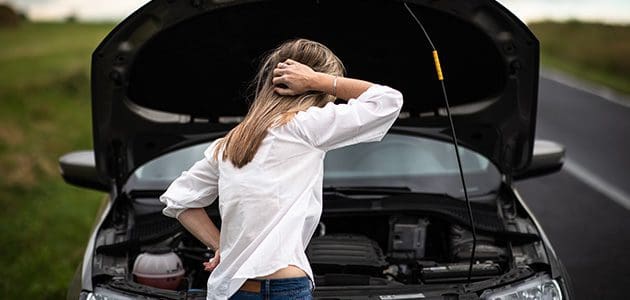- Car finance Car finance
- Motorbike finance Motorbike finance
- Van finance Van finance
- How it works How it works
- FAQs and guides FAQs and guides
- About us About us
- Home
- Blog
- Looking After Your Vehicle
- What is fair wear and tear for a car on finance?
What is fair wear and tear for a car on finance?
Updated: Tuesday, 31 October 2023
If you purchase a car on finance or hire a vehicle on a leasing or rental agreement, you’ll likely hear the term ‘fair wear and tear’.
Understanding what fair wear and tear means is important for ensuring you don’t find yourself with unexpected charges when you hand back the vehicle at the end of the agreement.
In this guide, we explain what fair wear and tear is based on the BVRLA guidance, and how it differs from excessive wear or damage. Most companies follow the BVRLA’s guidance as this is considered the industry standard. If you are unsure, contact your lender or check your contract.
What is fair wear and tear?
The British Vehicle Rental and Leasing Association’s (BVRLA) Fair Wear and Tear guide defines fair wear and tear as:
“…[something that] occurs when normal usage causes deterioration to a vehicle. It is not to be confused with damage, which occurs as a result of a specific event or series of events such as impact, inappropriate stowing of items, harsh treatment, negligent acts or omissions.”
In practice, this means vehicle finance and rental companies accept that there will be some unavoidable signs of deterioration due to regular, everyday usage. These signs include cosmetic imperfections and mechanical wear that occur when driving.
Think of it in terms of a new pair of trainers. When you first take them out of the box and put them on, they’ll be free from defects, marks, and dirt. But, after wearing them outside for a period of weeks or months, they’ll likely have discoloured soles and slight scuffs around the toes. These signs of wear are unavoidable and would be classed as fair.
However, it’s essential to distinguish fair wear and tear from damage caused by accidents, negligent acts and improper use. For example, driving recklessly could result in you bumping into other vehicles, walls, kerbs, or bollards, and intentionally driving in the wrong gear would likely put undue stress on your car’s mechanics. You could avoid these signs of wear by driving more carefully, so they aren’t classed as fair.
Most vehicle finance companies follow the BVRLA’s definition of fair wear and tear, as it is considered the industry standard. However, some lenders use their own definition, so if you’re unsure, check your contract or ask your lender.
What counts as fair wear and tear for cars?
Typically, car finance providers and dealerships consider the following signs of wear and tear to be acceptable.
Exterior
The following are considered fair wear and tear:
If you purchase a car on finance or hire a vehicle on a leasing or rental agreement, you’ll likely hear the term ‘fair wear and tear’.
Understanding what fair wear and tear means is important for ensuring you don’t find yourself with unexpected charges when you hand back the vehicle at the end of the agreement.
In this guide, we explain what fair wear and tear is based on the BVRLA guidance, and how it differs from excessive wear or damage. Most companies follow the BVRLA’s guidance as this is considered the industry standard. If you are unsure, contact your lender or check your contract.
What is fair wear and tear?
The British Vehicle Rental and Leasing Association’s (BVRLA) Fair Wear and Tear guide defines fair wear and tear as:
“…[something that] occurs when normal usage causes deterioration to a vehicle. It is not to be confused with damage, which occurs as a result of a specific event or series of events such as impact, inappropriate stowing of items, harsh treatment, negligent acts or omissions.”
In practice, this means vehicle finance and rental companies accept that there will be some unavoidable signs of deterioration due to regular, everyday usage. These signs include cosmetic imperfections and mechanical wear that occur when driving.
Think of it in terms of a new pair of trainers. When you first take them out of the box and put them on, they’ll be free from defects, marks, and dirt. But, after wearing them outside for a period of weeks or months, they’ll likely have discoloured soles and slight scuffs around the toes. These signs of wear are unavoidable and would be classed as fair.
However, it’s essential to distinguish fair wear and tear from damage caused by accidents, negligent acts and improper use. For example, driving recklessly could result in you bumping into other vehicles, walls, kerbs, or bollards, and intentionally driving in the wrong gear would likely put undue stress on your car’s mechanics. You could avoid these signs of wear by driving more carefully, so they aren’t classed as fair.
Most vehicle finance companies follow the BVRLA’s definition of fair wear and tear, as it is considered the industry standard. However, some lenders use their own definition, so if you’re unsure, check your contract or ask your lender.
What counts as fair wear and tear for cars?
Typically, car finance providers and dealerships consider the following signs of wear and tear to be acceptable.
Exterior
The following are considered fair wear and tear:

Minor scratches & chips
Chips to paintwork, minor scratches and scuffs, e.g. to door mirrors, up to a specific size limit, are all unavoidable and to be expected. However, scratches that reveal bare metal are not considered an effect of normal usage.

Small dents
In line with the BVRLA, dents up to 10mm are acceptable, provided no more than 2 per panel and the paint is not broken.

Wheel damage
Only slight wear to alloy wheels, like minor scuffs up to 25mm and scratches to wheel spokes, are permitted. Dents and holes to the steel rims and alloy wheels are not acceptable.

Light cracks
Small cracks to the windscreen and windows that don’t obstruct the driver’s line of view are acceptable. However, holes in the glass or plastic cover of lights, and cracked or missing door mirrors are not acceptable.

Minor scratches & chips
Chips to paintwork, minor scratches and scuffs, e.g. to door mirrors, up to a specific size limit, are all unavoidable and to be expected. However, scratches that reveal bare metal are not considered an effect of normal usage.

Small dents
In line with the BVRLA, dents up to 10mm are acceptable, provided no more than 2 per panel and the paint is not broken.

Wheel damage
Only slight wear to alloy wheels, like minor scuffs up to 25mm and scratches to wheel spokes, are permitted. Dents and holes to the steel rims and alloy wheels are not acceptable.

Light cracks
Small cracks to the windscreen and windows that don’t obstruct the driver’s line of view are acceptable. However, holes in the glass or plastic cover of lights, and cracked or missing door mirrors are not acceptable.
Vehicle interior
On the inside of your car, the following typically count as acceptable wear:
Vehicle interior
On the inside of your car, the following typically count as acceptable wear:

Light seat wear
Minor creasing and fading to the seats, passenger area, and trims are all expected. Similarly, the interior must be clean and odourless with no visible tears, burns or staining.

Worn controls
Normal wear to controls, like the radio and gear stick, and other knobs and switches can all be put down to typical use.

Minor scratches
Scratches on treads, sills and seals that reflect regular use are deemed acceptable. However, if floor coverings are split, or a tear occurs on surrounding trim panels, these are deemed unacceptable.

Small scuffs
Small scuffs and scratches to interior fittings like sun visors are expected, as with the outside of your car. However, the seat belts, rearview mirror, courtesy lights, visors, and door bins must all be intact and in working order.

In-car systems
All the car’s original equipment must be returned in total working order. If you have fitted any accessories, they must be removed and the originals re-fitted without any damage. Likewise, aerials must be left in place.

Light seat wear
Minor creasing and fading to the seats, passenger area, and trims are all expected. Similarly, the interior must be clean and odourless with no visible tears, burns or staining.

Worn controls
Normal wear to controls, like the radio and gear stick, and other knobs and switches can all be put down to typical use.

Minor scratches
Scratches on treads, sills and seals that reflect regular use are deemed acceptable. However, if floor coverings are split, or a tear occurs on surrounding trim panels, these are deemed unacceptable.

Small scuffs
Small scuffs and scratches to interior fittings like sun visors are expected, as with the outside of your car. However, the seat belts, rearview mirror, courtesy lights, visors, and door bins must all be intact and in working order.

In-car systems
All the car’s original equipment must be returned in total working order. If you have fitted any accessories, they must be removed and the originals re-fitted without any damage. Likewise, aerials must be left in place.
Mechanical and maintenance
Finally, the mechanical and maintenance-related problems below will typically be considered fair wear and tear unless the components’ condition is deemed negligent.
Tyre wear
All tyres, including the spare, must meet UK legal requirements and comply with the manufacturer’s tyre size, type, and speed rating recommendations.
The spare wheel, jack, and other tools, like emergency tyre inflation canisters, must be intact, stowed correctly and in good working order.
Mechanical condition
Mechanical and maintenance
Finally, the mechanical and maintenance-related problems below will typically be considered fair wear and tear unless the components’ condition is deemed negligent.
Tyre wear
All tyres, including the spare, must meet UK legal requirements and comply with the manufacturer’s tyre size, type, and speed rating recommendations.
The spare wheel, jack, and other tools, like emergency tyre inflation canisters, must be intact, stowed correctly and in good working order.
Mechanical condition
The vehicle must meet MOT standards, and any excessive wear to the components below highlights that the driver has neglected to service the car or failed to action warning lights and alerts from the vehicle management system:
- Brakes: Grooved brake discs or drums are typically caused by excessive wear or metal-to-metal contact from worn-out brake discs.
- Engine: Running with insufficient coolant or oil or broken internal components can damage and even seize the engine.
- Manual gearbox and clutch: If the clutch is slipping or the gearbox and clutch are making noises, this is a sign that the components are excessively worn.
- Automatic transmission: A noisy gearbox or torque converter, abrupt gear changes and loose gear linkage suggest an automatic transmission that has not been maintained well.

The vehicle must meet MOT standards, and any excessive wear to the components below highlights that the driver has neglected to service the car or failed to action warning lights and alerts from the vehicle management system:
- Brakes: Grooved brake discs or drums are typically caused by excessive wear or metal-to-metal contact from worn-out brake discs.
- Engine: Running with insufficient coolant or oil or broken internal components can damage and even seize the engine.
- Manual gearbox and clutch: If the clutch is slipping or the gearbox and clutch are making noises, this is a sign that the components are excessively worn.
- Automatic transmission: A noisy gearbox or torque converter, abrupt gear changes and loose gear linkage suggest an automatic transmission that has not been maintained well.

As well as ensuring all of these components are in good condition, you must consider how long you’ve had the car, the mileage, and the vehicle’s age. These factors will affect whether damage is deemed to be acceptable.
For example, if you have leased a brand-new car for a fortnight and the brakes are worn, this could be a sign that the vehicle has not been driven responsibly.
You should check your leasing or finance agreement to see what constitutes fair wear and tear. Many companies will include guides or checklists that explain what is considered acceptable wear and tear, and what is not.
What exceeds fair wear and tear for cars?
Regarding damage to the bodywork, light scratches up to 25mm are acceptable if they are not deep enough to reveal the prime or bare metal.
Likewise, dents of up to 10mm are allowed; however, there can only be two per panel. Dents on the roof or near door handles will not pass any inspections. Cracks in windows, mirrors, or lights must all be repaired, too.
Finance or leasing companies will not usually accept dents and holes in alloy wheels, although minor scuffs and scratches will usually pass inspections.
If there is rust, corrosion, or discolouration on any painted area, this typically falls outside of acceptable wear and tear too.
Are you charged for car damages outside of wear and tear?
Finance providers will likely charge you for damages exceeding fair wear and tear if you return the vehicle at the end of your contract.
Under these finance agreements, the amount you’re charged will depend on the repair costs. Slight cosmetic flaws, like scratches or scuffs to the paintwork, will likely not incur charges as great as more significant damages, like large dents to the bodywork or broken headlights.
With Conditional Sale (CS) finance agreements, you automatically become the vehicle’s owner when you make your last payment (there are no option to purchase fee or final balloon payment). This means you won’t need to worry about being sent a repair bill for any damages to your car.
However, if you choose to return your car to the lender and end your agreement early, the car needs to be in acceptable condition, and you will be charged for any repairs required. Any charges will be outlined in your contract.
Ways to avoid exceeding fair wear and tear for cars
To avoid paying extra fees for your car when you return it, there are things you can do before handing it back. This includes cleaning the vehicle inside and out and ensuring all documentation and additional equipment, like tow bars, are present.
Before you return your vehicle, inspect it to determine whether any chips or dents need fixing. Additionally, you could have the car checked by a professional to repair any faults.
Depending on the type of finance you have, for example leasing, you may need to report any damage to the lender, so that they can direct you to a mechanic approved by the leasing company. We can’t speak for other lenders, so if you’re not sure what you need to do, check your contract and speak to your lender.
On the day you return your car, you should ensure:
- You have all sets of keys for your car
- All tools, the spare wheel, and other equipment are in the car
- Your data is removed from the car’s computer system
- There is sufficient fuel in the car’s tank
- All relevant documents, like the logbook (V5C) and MOT certificates, are present.
More from Moneybarn
At Moneybarn, we specialise in offering bad credit car finance, and we’ve helped thousands of people across the UK onto a better road ahead. If you find it difficult to be accepted for car finance or have had previous applications refused, we could help.
Try out our car finance calculator to see what your agreement might look like.
Representative 30.7% APR.
FAQs about fair wear and tear for cars
Are car scratches wear and tear?
Scratches up to 25mm and not deep enough to expose the bare metal or primer are considered fair wear and tear.
Are scuffed alloys fair wear and tear?
Only slight wear to alloy wheels, like minor scuffs up to 25mm and scratches to wheel spokes, are permitted. Dents and holes to the steel rims and alloy wheels are not considered fair wear and tear.
Should you fix scratches on a leased car?
If a scratch on your car is larger than 25mm, you may be charged as part of the finance company’s fair wear and tear policy.
Repairs may be acceptable so long as they are completed by a professional mechanic, but we can’t speak for all lenders, and some might require you contact them directly so they can arrange repairs as per their policy.
How much does wear and tear cost on a car?
The wear and tear costs you are charged will depend on the damage your car has sustained. We recommend speaking to your finance provider directly to find how much you may be charged.
Additionally, you must think about the mileage and the vehicle’s age. These factors will impact what’s considered fair wear and tear and how much you may be charged.
As well as ensuring all of these components are in good condition, you must consider how long you’ve had the car, the mileage, and the vehicle’s age. These factors will affect whether damage is deemed to be acceptable.
For example, if you have leased a brand-new car for a fortnight and the brakes are worn, this could be a sign that the vehicle has not been driven responsibly.
You should check your leasing or finance agreement to see what constitutes fair wear and tear. Many companies will include guides or checklists that explain what is considered acceptable wear and tear, and what is not.
What exceeds fair wear and tear for cars?
Regarding damage to the bodywork, light scratches up to 25mm are acceptable if they are not deep enough to reveal the prime or bare metal.
Likewise, dents of up to 10mm are allowed; however, there can only be two per panel. Dents on the roof or near door handles will not pass any inspections. Cracks in windows, mirrors, or lights must all be repaired, too.
Finance or leasing companies will not usually accept dents and holes in alloy wheels, although minor scuffs and scratches will usually pass inspections.
If there is rust, corrosion, or discolouration on any painted area, this typically falls outside of acceptable wear and tear too.
Are you charged for car damages outside of wear and tear?
Finance providers will likely charge you for damages exceeding fair wear and tear if you return the vehicle at the end of your contract.
Under these finance agreements, the amount you’re charged will depend on the repair costs. Slight cosmetic flaws, like scratches or scuffs to the paintwork, will likely not incur charges as great as more significant damages, like large dents to the bodywork or broken headlights.
With Conditional Sale (CS) finance agreements, you automatically become the vehicle’s owner when you make your last payment (there are no option to purchase fee or final balloon payment). This means you won’t need to worry about being sent a repair bill for any damages to your car.
However, if you choose to return your car to the lender and end your agreement early, the car needs to be in acceptable condition, and you will be charged for any repairs required. Any charges will be outlined in your contract.
Ways to avoid exceeding fair wear and tear for cars
To avoid paying extra fees for your car when you return it, there are things you can do before handing it back. This includes cleaning the vehicle inside and out and ensuring all documentation and additional equipment, like tow bars, are present.
Before you return your vehicle, inspect it to determine whether any chips or dents need fixing. Additionally, you could have the car checked by a professional to repair any faults.
Depending on the type of finance you have, for example leasing, you may need to report any damage to the lender, so that they can direct you to a mechanic approved by the leasing company. We can’t speak for other lenders, so if you’re not sure what you need to do, check your contract and speak to your lender.
On the day you return your car, you should ensure:
- You have all sets of keys for your car
- All tools, the spare wheel, and other equipment are in the car
- Your data is removed from the car’s computer system
- There is sufficient fuel in the car’s tank
- All relevant documents, like the logbook (V5C) and MOT certificates, are present.
More from Moneybarn
At Moneybarn, we specialise in offering bad credit car finance, and we’ve helped thousands of people across the UK onto a better road ahead. If you find it difficult to be accepted for car finance or have had previous applications refused, we could help.
Try out our car finance calculator to see what your agreement might look like.
Representative 30.7% APR.
FAQs about fair wear and tear for cars
Are car scratches wear and tear?
Scratches up to 25mm and not deep enough to expose the bare metal or primer are considered fair wear and tear.
Are scuffed alloys fair wear and tear?
Only slight wear to alloy wheels, like minor scuffs up to 25mm and scratches to wheel spokes, are permitted. Dents and holes to the steel rims and alloy wheels are not considered fair wear and tear.
Should you fix scratches on a leased car?
If a scratch on your car is larger than 25mm, you may be charged as part of the finance company’s fair wear and tear policy.
Repairs may be acceptable so long as they are completed by a professional mechanic, but we can’t speak for all lenders, and some might require you contact them directly so they can arrange repairs as per their policy.
How much does wear and tear cost on a car?
The wear and tear costs you are charged will depend on the damage your car has sustained. We recommend speaking to your finance provider directly to find how much you may be charged.
Additionally, you must think about the mileage and the vehicle’s age. These factors will impact what’s considered fair wear and tear and how much you may be charged.
Bringing you tips on buying and maintaining your vehicle to make life on the road less stressful.
More from Moneybarn...
For a better road ahead
Moneybarn is a member of the Finance and Leasing Association, the official trade organisation of the motor finance industry. The FLA promotes best practice in the motor finance industry for lending and leasing to consumers and businesses.
Moneybarn is the trading style of Moneybarn No. 1 Limited, a company registered in England and Wales with company number 04496573, and Moneybarn Limited, a company registered in England and Wales with company number 02766324. The registered address for these companies is: Athena House, Bedford Road, Petersfield, Hampshire, GU32 3LJ.
Moneybarn’s VAT registration number is 180 5559 52.
Moneybarn Limited is authorised and regulated by the Financial Conduct Authority (Financial Services reference No. 702781)
Moneybarn No. 1 Limited is authorised and regulated by the Financial Conduct Authority (Financial Services reference No. 702780)




